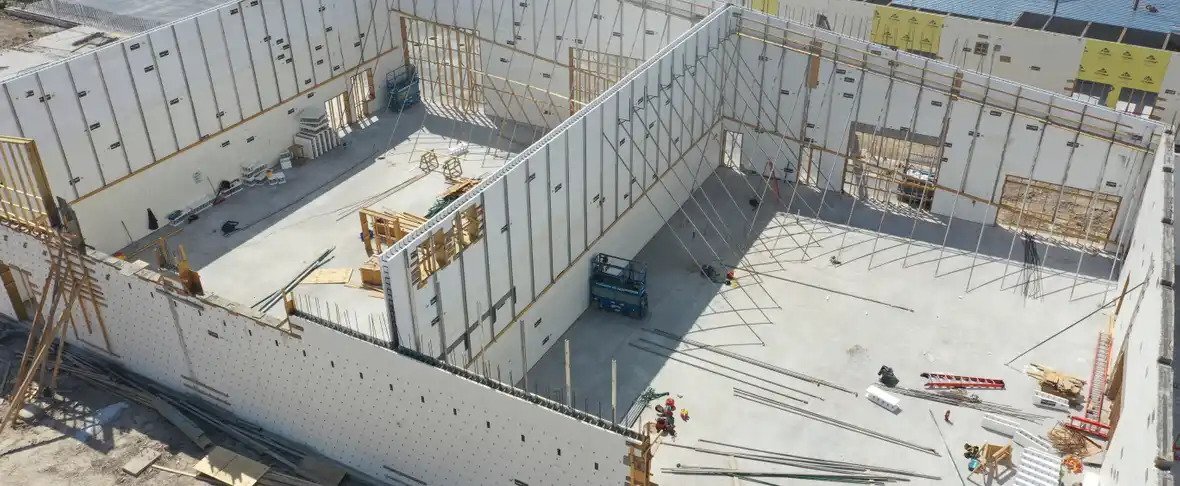
The Integrated Design Process (IDP) and Insulated Concrete Forms (ICFs)

The Integrated Design Process (IDP) strives to build a sustainable society through a more thoughtful building design process. A key component of this process is choosing building materials and methods that highlight the goals of IDP that include longevity, energy efficiency, and sustainability. Building materials like insulated concrete forms are uniquely positioned to strengthen the Integrated Design Process.

What is the Integrated Design Process?
The Integrated Design Process (IDP) began in the early 1990s by Canada’s C-2000 program and IDEAS Challenge competition. The purpose was to define a more holistic approach to building design, by embracing new methods and materials for building design. IDP sought to totally revamp the building design process in order to build something better.
IDP can be hard to define, but is often thought of as an intentional way of approaching sustainable building and community design that offers a much higher likelihood of success than competing approaches. IDP incorporates common goals into the design process and highlights common features including:
Goal-Driven
Sustainability is the primary goal but secondary goals should be explicitly highlighted. Objectives and targets are used as guidelines to ensure a project stays on track to hit the desired goals.
Facilitated
Having a party dedicated to the process of design helps to add accountability to the process. This person facilitates the building design by being removed from the actual building design team and is solely accountable for the process.
Structured
Issues and decisions must be accomplished in the right order to prevent non-reversible decisions from being made without the pertinent information. Making decisions with complete input and information leads to overall improved performance and better designs.
Clear Decision-Making
Conflict resolution is a large aspect of any project. IDP encourages a clearly understood methodology for making decisions and resolving conflict.
Inclusive
All parties play a role in building design, from the owner to the operator. Hearing from all involved parties in the design phase helps ensure that the completed building will be considered a success by all involved parties.
Collaborative
The architect is just one involved party in the building design process. The architect should lead discussions with the broader team and encourage other members of the team to play active roles in the process.
Iterative
New information will come to light throughout the design process. This new information should be used purposefully to support new decision-making and refine old decisions.
The Purpose of IDP
By bringing all of these aspects and more into the design process, IDP strives to build a sustainable society. Through more thoughtful design, IDP hopes to reduce the ecosystem degradation that plagues modern society.
In Canada, building design, construction, operation, and demolition make up 30 percent of energy use and 38 percent of greenhouse gases. Improvements to the building design process are uniquely positioned to have significant impact.
Potential synergies and savings are abundant early in the design process while the cost to make changes is also low. As the design process progresses through schematic design, design development, construction, and occupancy, costs to change become much higher with less savings to be gained. IDP wants to build better buildings, more efficiently at less cost, through a more thoughtful design process.
IDP and Fox Blocks ICFs: A True Synergy
IDP benefits from out-of-the-box thinking and novel approaches to traditional building methods. Insulated concrete forms (ICFs) check many of the boxes that IDP needs when it comes to new building materials and methods for any building type.

ICF blocks consist of two sheets of insulation held together through a proprietary tie system that forms a hollow space in-between the sheets. The blocks are stacked together at a construction site to form the wall structures of the building. Once assembled, rebar is added to the space in-between the insulation. Concrete is then poured in the hollow and allowed to set. The resulting insulated, steel-reinforced concrete structure is long-lasting, highly energy-efficient, and sustainable.
Built to Last
ICF homes and buildings are inherently resistant to natural disasters while being low maintenance for home and building owners as well. Concrete is naturally fire-resistant and with steel reinforcement can be strong enough to be used as a storm shelter. ICF construction is so strong that many traditional homes and buildings destroyed in natural disasters are then rebuilt with ICFs.
Energy-Efficient
ICF construction allows a building to quickly be constructed with both interior and exterior layers of continuous insulation. ICF walls naturally avoid issues like thermal bridging that commonly occur in traditional wall construction. The simple ICF building method also reduces opportunities for human error which leads to more consistent construction practices for any building type.. Fox Blocks ICF blocks are rated at an R-value of greater than 22.

In addition to excellent insulation values, ICF blocks also have a great deal of thermal mass from all of the concrete in the walls. This mass of concrete heats up and cools down slowly which serves to dampen fluctuations in temperature. The interior of ICF buildings stays at a more consistent temperature regardless of the conditions outside.
Sustainable
ICF buildings are not only long-lasting and energy-efficient, but they are sustainable too. ICF blocks from Fox Blocks contain 40% recycled content by weight. The blocks do not off-gas and are not made with any gasses that deplete the ozone layer or harm the environment. Fox Blocks are easier to build with, and reduce cost and material wastage during construction. With ICF construction, the building will be around for a very long time.
When it comes to IDP, the goal is to build a sustainable society. ICF blocks help build a more sustainable society through their longevity, energy efficiency, and sustainability.
To learn more about ICF blocks and their sustainability characteristics, reach out to our expert team at Fox Blocks today!